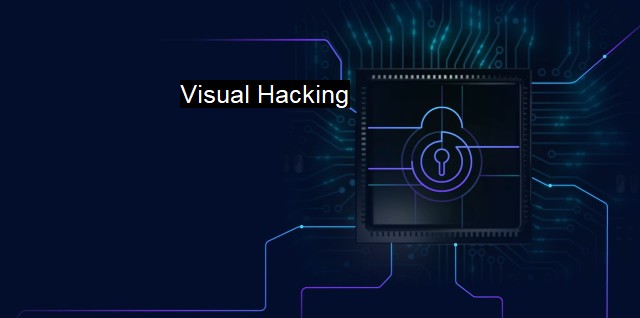What is Visual Hacking?
The Rise of Visual Hacking: Protecting Yourself and Your Business in a Tech-Dominated World
Visual hacking is a simple, yet widely overlooked, aspect of cybersecurity that can expose a substantial amount of confidential data. Visual hacking refers to the act of capturing or viewing sensitive, classified or private data for unauthorized use. the process involves hackers directly visualizing or indirectly acquiring screenshots or images of someone's computer screen to access confidential data.Visual hacking can take several forms: it could be as straightforward as someone looking over your shoulder as you type in a password (also known as shoulder surfing), or as intricate as using sophisticated digital cameras or mobile smartphones to capture images or snapshots of someone's screen containing sensitive information. Given that it relies on simple visuals rather than complex hacking systems or codes, visual hacking can be executed by almost anyone, making it a risk businesses should not disregard.
Unlike other forms of hacking, which usually require specialized skills and technology to infiltrate networks or systems, visual hacking takes the pathway of exploiting human vulnerabilities. Since it isn't reliant on complicated cyber techniques, any effectively trained individual can work as a visual hacker. This hacking form often combines social manipulation with opportunistic surveillance, taking advantage of users who neglect privacy screens or forget to regularly change passwords.
Visual hacking is particularly harmful because it allows cybercriminals access to information that might not be obtainable through other hacking techniques. multi-factor authentication procedures often ask users to input a one-time-password (OTP) received through texts or email. Visual hacking can easily bypass this security feature since the OTP is displayed on user's screens and the hacker nearby can courageously peek at it.
There is also a concerning issue of what constitutes as a responsible reaction to spotting visual hacking attempts. For instance, if a worker in a communal office environment notices a fellow employee trying to steal a look at their laptop screen, it is not always clear how to respond — causing the offender to continue with their unmonitored actions.
Businesses have a vested interest in mitigating visual hacking, not just from a privacy perspective, but also in terms of regulatory compliance. Several privacy laws around the world lay firm in holding businesses accountable for protecting customer data, and any infringement on this can result in hefty fines or damaging public scandals.
As a form of mitigation, many experts in cybersecurity recommend the use of privacy filters or anti-glare protectors for devices in busy public areas. They create a narrow viewing angle so that only the person directly in front of the screen can read what's on it. This procures a much-needed layer of physical protection and semi-resolution towards impudent surveillance attempts.
In line with this, education and sensitizing employees about the risks and consequences of visual hacking is also a good investment. Organizations should, therefore, instigate cybersecurity awareness programs that incorporate privacy measures against visual hacking. hackers can easily follow our digital breadcrumbs to gain entry into restricted systems if we are negligent, hence awareness around proper password use, investment in robust antivirus software, and other cybersecurity tips should be disseminated.
Imposing strict screen time-out settings when computers are idle can safeguard against point-blank visual hacking, prodding users to regularly lock down their screens or having systems set up to auto-logout after a certain period of inactivity.
Visual hacking, given its insidious nature, slips under the radar while posing significant security threats. Despite its lack of technical complexity, the consequences of data breaches caused by this hacking form shouldn't be trivialized. Companies must therefore account for this understated fraud, implement comprehensive defenses, and consistently monitor potential vulnerabilities to reinforce their cybersecurity shield against visual hacks.

Visual Hacking FAQs
What is visual hacking?
Visual hacking is a type of cyber attack that involves visually stealing sensitive information by observing or looking over someone's shoulder or the computer screen. It is a type of social engineering attack that exploits human vulnerability rather than technical vulnerabilities.How can visual hacking be prevented?
Visual hacking can be prevented by implementing security awareness programs, training employees on the importance of security, and creating a culture of security. Additionally, privacy filters can be used on computer screens to limit the visibility of information to only authorized individuals.What are the consequences of visual hacking?
The consequences of visual hacking can be severe, resulting in data breaches, loss of sensitive information, and financial damages. It can also lead to reputational damage, loss of customer trust, and legal penalties.Can antivirus software prevent visual hacking?
Antivirus software is not designed to prevent visual hacking, as it is a social engineering attack that targets human vulnerabilities rather than technical vulnerabilities. However, antivirus software can prevent other types of cyber attacks such as malware, ransomware, and phishing attacks.| | A | | | B | | | C | | | D | | | E | | | F | | | G | | | H | | | I | | | J | | | K | | | L | | | M | |
| | N | | | O | | | P | | | Q | | | R | | | S | | | T | | | U | | | V | | | W | | | X | | | Y | | | Z | |
| | 1 | | | 2 | | | 3 | | | 4 | | | 7 | | | 8 | | |||||||